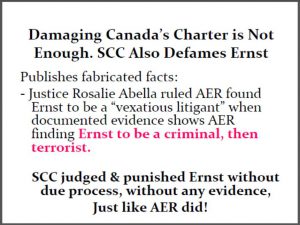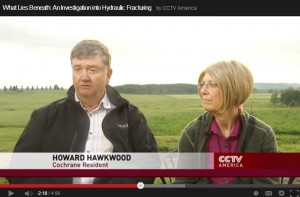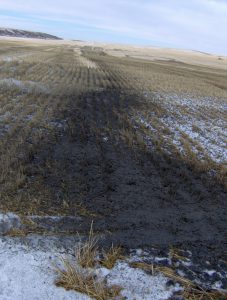A little frac history:
2004: Ernst asks EUB (later became ERCB, then AER) and Alberta Environment to enforce the law and regulate out-of-control frac’ing by Encana/Cenovus/Ovintiv in her community, only to be bullied, harassed and lied to.
2005: EUB violated Ernst’s Charter rights trying to intimidate her silent, in writing no less.
2006 06 08: EUB’s lawyer Rick McKee told Ernst, in front of a witness, that she would only get help and regulation if she shut up and stopped warning others about frac harms, which Ernst told him she would never do.
2006 09 20: Ernst writes Alberta’s Chief Medical Officer of Health, Nicolas Bayliss, asking him to help the Rosebud community after Encana/Cenovus/Ovintiv’s illegal fracs and many harms. He writes back the next day, promising help, then goes silent.
2006 12 08: Alberta Health Chief Medical Officer of Health Nicolas Bayliss steps down without helping Albertans poisoned by fracing
2007 05 08: Ernst testifies in Ottawa to Parliamentary Committee, beseeches the gov’t to implement CEPA (1999) and enforce chemical disclosure of all toxic oil and gas industry drilling, fracing and servicing fluids, which the Harper government never did. Encana VP Stacy Knull, Alberta Geological Survey-EUB-Alberta Environment were too chicken to testify, pulling out, some at the last minute; CAPP and another oil & gas propaganda group, CSUG (became CSUR), shakily testified via TV from Calgary even though they were not on the witness list (which violated testimony rules) and lied a lot.
2009: Harper’s anti-terrorist squad trespass at Ernst’s home, trying to intimidate Ernst (on orders by Encana/Ovintiv?) a few months after she served legal papers on Encana, AER and the Alberta gov’t.
2012: Ernst asks Alberta Health and other agencies for help:

2013: Alberta gov’t brings in REDA (a ridiculously dishonest name), changing the regulator to AER (apparently in response to Ernst’s lawsuit), removes public interest from its mandate

2015: Fracing’s long reach: Fracking Wells Could Pollute The Air Hundreds Of Miles Away

2015 05 09: After 3,600 frac’d/stimulated wells in Ontario: Private member’s bill to ban high volume fracing passes second reading The bill went nowhere, of course.
2017: Nasty! Supreme Court of Canada pisses on the rule of law, damages Canada’s Charter and knowingly lies in their ruling in Ernst vs AER. Worse, the court sends the lie to the media but not the part of their ruling where the lie is specified as such.


2020 01 21: Here’s how synergy spin by Canadian Association of Physicians for the Environment – CAPE – is used: Get media to wrongly define hydraulic fracturing to keep industry happy & frac’ing, just like Sierra Club and Council of Canadians do. Straight reports: “Canadian doctors link” frac’d gas to health harms, but not one doctor wrote the report; the lead author is not even part of the doctors’ association
2020: As of the date of this post, still no federal or provincial health or energy regulatory agency in Canada provided Ernst and her community or the many others harmed by frac’ing any help (and, the courts and Ernst’s own lawyers, Murray Klippenstein and Cory Wanless, lied and punished Ernst, devoutly pissing on the public interest and rule of law).
Our illegally frac’d drinking water aquifers remain frac’d by Encana/Ovintiv, a cowardly bully company that has run away to the USA.
To read more galling details about how Encana/Ovintiv and the regulators and courts treated the public interest and me, read Andrew Nikiforuk’s Slick Water.

Fracking Has a Radioactive Problem; Living within 12 miles of a fracking site could make you sick, scientists say by Caroline Delbert, Oct 26, 2020, Popular Mechanics
Scientists say the areas around fracking sites have up to 40 percent more airborne radioactive particles.
As an unorthodox way to extract materials, fracking has presented research challenges.
Researchers suggest not living within 12 miles of a fracking location.
Harvard scientists have found that fracking is associated with greatly increased radioactive particulate in the air, especially in West Virginia’s dependent petrochemical economy. People who live within about 12 miles of fracking sites are at the highest risk, with ambient radiation as high as 40 percent over the background level.
The data comes from 17 years of measurements at over 150 radiation monitoring sites. Scientists examined these measurements, combined with the location data on more than 120,000 fracking wells. While experts have known fracking can release chemicals into the groundwater in particular, this is the first study to analyze radiation levels.
Fracking may be a lot of things, but the idea that it’s literally radioactive could be surprising. The reason is that a lot of underlying rock contains small amounts of uranium, for example, as part of the naturally occurring bedrock found all over Earth. Where conventional mining adds safety precautions and traditional oil drilling doesn’t interact with bedrock the same way, fracking has gone a third way that pulverizes the bedrock and releases the uranium.
The study refers to fracking by a technical name: unconventional oil and natural gas development (UOGD).
“As of 2017, over 120,000 onshore UOGD wells had been drilled via a practice involving directional drilling combined with multistage high-volume hydraulic fracturing (fracking),” the researchers explain in the paper. “Meanwhile, numerous controversies have arisen, partially due to the potential harmful impacts on the local environment, and on the health of nearby residents.”
Without an established track record of research, scientists can’t make meaningful observations about how fracking is affecting radiation in the air or not. The nationwide network of radiation observatories, built during the Cold War when nuclear war was an ever-present fear, offers a unique chance to triangulate fracking locations and radiation levels.
The scientists crunched the data for each radiation measurement in combination with the many fracking sites—1.5 million total—that dot the U.S. They found that radiation sites within 12 miles of heavy fracking activity, as the wind blows, had higher radiation levels than are otherwise explained.
“These associations suggested the existence of some pathways by which UOGD activities could release [radioactive material] into the atmospheric environment,” the researchers say. They conclude:
“Likely mechanisms include the fugitive release of natural gas, which contains a higher-than-background level of radon at wellheads, compressor stations, pipelines, and other associated facilities; the management, storage, discharge and disposal of flow-back and produced water which is rich in [radioactive materials]; the accidental spill or beneficial use of produced water in nearby communities; the handling, transport, management, and disposal of radioactive drill cuttings.”
There are a lot of places in the process where radiation could be leaking into the air. But with data in hand, the people in charge of fracking wells can examine these risk factors up close and make simple changes, whether that’s better gaskets or more careful filtering of waste water released into communities. ![]() Ya but … that costs money, which oil and gas companies refuse to spend, notably if it’s to reduce harms to us and our environment or prevent drinking water contamination. The money is instead demanded by multimillionaires and billionaires to go into their greedy bulging inhumane pockets. Besides, 1) it’s been proven that regulating frac’ing will not make it safe; 2) companies just ignore regulations to fulfill their profit-raping pleasures and 3) regulators, courts and politicians ignore the companies ignoring regulations.
Ya but … that costs money, which oil and gas companies refuse to spend, notably if it’s to reduce harms to us and our environment or prevent drinking water contamination. The money is instead demanded by multimillionaires and billionaires to go into their greedy bulging inhumane pockets. Besides, 1) it’s been proven that regulating frac’ing will not make it safe; 2) companies just ignore regulations to fulfill their profit-raping pleasures and 3) regulators, courts and politicians ignore the companies ignoring regulations.![]() Just like natural gas, knowledge is power.
Just like natural gas, knowledge is power.

Refer also to:



Fracking the Hawkwoods near Calgary, dead cows and…RADIATION?




Unconventional oil and gas development and ambient particle radioactivity by Longxiang Li, Annelise J. Blomberg, John D. Spengler, Brent A. Coull, Joel D. Schwartz & Petros Koutrakis, Oct 13, 2020, Nature Communications volume 11, 5002 (2020)
Abstract
Unconventional oil and natural gas development (UOGD) expanded extensively in the United States from the early 2000s. However, the influence of UOGD on the radioactivity of ambient particulate is not well understood. We collected the ambient particle radioactivity (PR) measurements of RadNet, a nationwide environmental radiation monitoring network. We obtained the information of over 1.5 million wells from the Enverus database. We investigated the association between the upwind UOGD well count and the downwind gross-beta radiation with adjustment for environmental factors governing the natural emission and transport of radioactivity. Our statistical analysis found that an additional 100 upwind UOGD wells within 20 km is associated with an increase of 0.024 mBq/m3 (95% confidence interval [CI], 0.020, 0.028 mBq/m3) in the gross-beta particle radiation downwind.
… The extraction of crude oil and natural gas from the low-permeability unconventional geological accumulating formation (known as unconventional oil and natural gas development [UOGD]) expanded extensively over the past decade. As of 2017, over 120,000 onshore UOGD wells had been drilled via a practice involving directional drilling combined with multistage high-volume hydraulic fracturing (fracking)1. Meanwhile, numerous controversies have arisen, partially due to the potential harmful impacts on the local environment2,3,4,5,6,7, and on the health of nearby residents8,9,10,11.
Naturally occurring radioactive material (NORM) is a common by-product in Oil and Gas (O&G) production industry.
The concentration of Uranium-238 in sedimentary formation rich in organic matter, such as black shale, is significantly higher than the background level of in earth’s crust due to the natural attenuation process12,13. Before widespread UOGD, studies had detected above-background levels of Radium-226, a decay product of U-238, in the wastes of conventional oil and natural gas development (COGD)14,15.
Regarding UOGD, enhanced levels of U-238 and Ra-226 have recently been detected in the produced water from unconventional hydrocarbon reservoirs16,17, in the drill cuttings from the lateral drilling within the unconventional formation18,19,20, in the impoundment sediments21, in the soil of brine spill accident scene22, and in the stream sediments near discharging sites23.
Two studies in the Marcellus shale region found a positive association between UOGD activities and indoor levels of Radon-222, a gaseous decay product of Ra-22624,25.
… These associations suggested the existence of some pathways by which UOGD activities could release NORM into the atmospheric environment. Likely mechanisms include the fugitive release of natural gas, which contains a higher-than-background level of radon at wellheads, compressor stations, pipelines, and other associated facilities38,39,40; the management, storage, discharge and disposal of flow-back and produced water which is rich in NORMs16,41,42,43; the accidental spill or beneficial use of produced water in nearby communities22; the handling, transport, management, and disposal of radioactive drill cuttings18,19. The results of our negative control analysis suggested the potential transport mechanism of PR independent of atmospheric movement. This association could be explained by the increased off-site radon emission, or by the nearly isostropic dispersion of radon released on site under low-wind condition. To distinguish the contributions of these surface activities, more continuous measurements of PR, especially for some specific radionuclides, are needed at a finer spatiotemporal resolution.
Our results showed a remarkable distinction between the impacts of UOGD and COGD on PR. UOGD-specific processes, such as hydraulic fracturing and directional drilling, could potentially explain the larger associated impacts. The high-volume hydraulic fracturing process produced large volumes of flow-back water and drilling mud, which are subsequently stored in the temporary reserve pit adjacent to the drilling site. Most UOGD production states allow the operator to close the reserve pit within up to one year after completing the drilling44. This practice potentially enables the NORMs in the produced water to decay into radon above the ground surface and release the radon into the ambient environment. The lateral drilling process produces large volumes of drill cuttings from the unconventional accumulating formation, whose levels of NORMs are higher than those produced during the vertical drilling stage. These drill cuttings are currently not considered hazardous wastes by U.S. EPA. The practice of beneficial use of drill cuttings and land treatment could potentially release radon into the ambient environment45. …
Our analysis demonstrates that upwind UOGD activities could significantly elevate the PR level in downwind communities. UOGD has a larger impact on PR, compared to COGD. Based on previously published health effect analysis of PR, it is possible that the widespread of UOGD could induce adverse health effects to residents in proximity by elevating the PR. …
***
Encana/Ovintiv at Rosebud Alberta:

Encana/Ovintiv dumping its waste heavy just upwind of the community of Rosebud. It’s often extremely windy in Alberta, spreading industry’s toxic and radioactive waste into our lungs, not even respecting us and our bodies on Sundays for one day a week of rest from the harms. The waste is dumped, 24/7, even in extreme wind while residents are leaving church as in the photo below of Encana/Ovintiv dumping on a Sunday, with massive clouds of the waste spray airborne, blowing towards the church.

Where’s the regulator, the AER?
Hiding in cities to avoid being exposed to the many (secret) harmful frac chemicals and radioactivity.

